How to Repair a Window Sash Cord
by: Dale Cox
Old double-hung (two sash) windows may have a cotton cord or a metal chain attached to the counterweight that supports the sashes and keeps them balanced in the jamb. Over many years these cords can break and make it hard to raise the sash and impossible to keep it up. The procedure on this page can be used to repair both types of broken sash cord. Check here for a video demonstrating how to repair a broken sash cord.
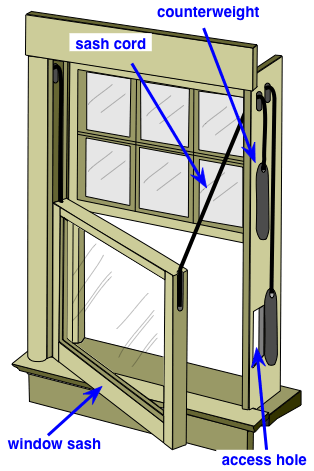
This diagram illustrates the anatomy of a double-hung window and the pulley/weight system used to raise and lower the sashes. All these types of windows work in the same way, a cast iron weight is attached with a cord to both sides of each sash. The cord runs up to the top of the window jamb, through a pulley channel, and down to the weight inside the jamb. As the sash moves up and down the counterweight keeps it balanced and held in place.
To repair the cord on a window like this, the counterweight inside must be reattached to the sash with a new cord. This would be a simple task if not for the need to open the jamb to get to the cast iron weight inside. Fortunately most old, double-hung wooden windows have an access panel cut into the lower sash channel for this very purpose.
What You'll Need
- 5/16 inch sash cord
- hammer
- broad chisel
#1 - Remove the Window Sash
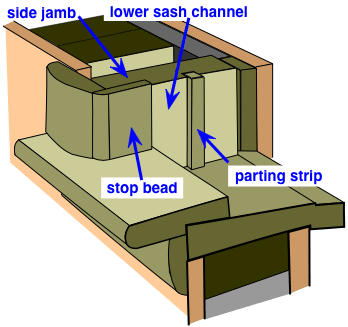
Start the repair by removing the stop bead on one side of the window casing. Hold a broad chisel with the flat toward the jamb and drive it behind the bead at regular intervals to loosen the nails and pry it off. Remove the stop bead completely and pull the nails out. Set it aside.
To remove the bottom window sash, lower it all the way and pull it out from the bottom where the stop bead was removed. If both cords are broken, remove the sash completely and set it aside while you string the counterweights. If only one cord is broken, pull the sash free from the casing and let the good counterweight hold it off to the side while you work.
#2 - Remove the Counterweight Access Panel
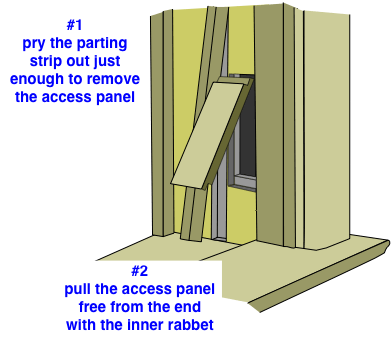
Remove the access panel in the sash channel to get to the counterweight. If the panel is held in by a parting strip, use the chisel to pry it from its groove. Starting at the sill, drive the chisel along the side of the strip to pry it out. Dig into the wood slightly with the chisel to get a grip and pry the parting strip free as far up the jamb as needed to remove the access panel.
If there are nails or screws holding the panel in place, remove them. Opposing rabbets will usually be cut in the panel cover, one on the face and one on the back. Pull the panel free from the end with the rabbet on the back. You'll have to try lifting the ends to discover which is the right one.
#3 - Tie a New Cord to the Counterweight
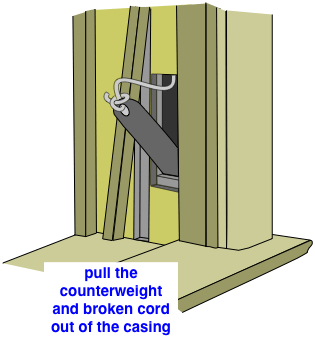
Reach through the access hole and pull the loose counterweight and broken cord out. Remove the old, broken cord paying attention to how it is tied. You should use the same technique to tie the new cord. If you have trouble duplicating the knot just use a double knot that you are sure won't come loose.
Cut a piece of cord long enough to reach from the sill of the window, up to pulley at the top and down to the sill again. Push one end of the cord through the top of the pulley opening and into the cavity. Roll the cord on the pulley wheel with your finger to push it into the cavity behind the jamb. Keep pushing cord through the pulley, letting it bunch up inside the jamb.
Use a wire hanger or similar device bent into a hook on one end to reach through the access hole and snag the bunched-up cord. Pull the end down and through the access hole. Pull some extra cord through the hole, making sure not to pull the other end into the cavity above. Tie the end of the cord to the counterweight. Set the weight back into the casing and pull the cord from the pulley side to lift and lower the weight making sure it moves freely.
#4 - Attach the Cord to the Sash
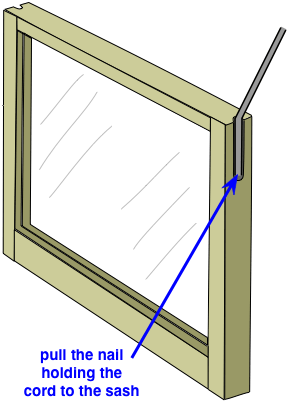
Measure the length of the groove in the side of the sash and add about 5 inches to this length. While suspending the weight 4 or 5 inches above the sill level, hold the sash in the jamb at its highest position and mark the cord at the top of the sash with a pencil.
Set the sash aside and cut the cord to length. From the pencil mark, add the groove measurement and cut the cord at that point. Be careful not to let the end fly up and into the pulley hole. Tie a tight knot in the end and insert a long nail or screw through it to keep the cord from being pulled in through the pulley hole.
Remove the old broken cord from the window sash. A nail is usually driven through a knot in the end of the cord and into the side. Pull the nail free with needle-nosed pliers and save it. While holding the sash in the casing again, tilt the side out to access the groove. Pull the new cord down from the pulley, remove the long nail, and reinsert the nail you removed earlier. Tuck the knot and cord into the side channel on the sash so it doesn't protrude and drive the nail into the sash using the same hole it came from. Use a phillips screwdriver or a nail set to sink the nail until it's tight. Slip the sash back into place and gently raise it into the open position.
Install the access panel and refasten it. Tap the parting strip back into its groove and pull the window sash down. Install the stop bead, lining the nails up to go back into their original holes. Gently drive the nails home. Test the window for glide, if it binds, use the chisel to nudge the stop bead out a little until it moves freely. Caulk the stop bead if necessary and touch up the paint.
 Window Framing
Window Framing